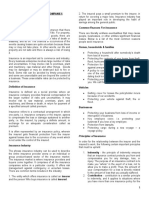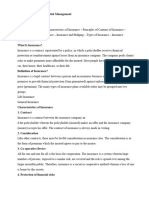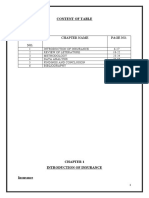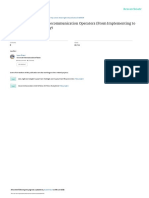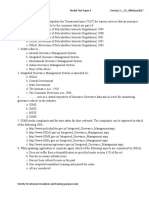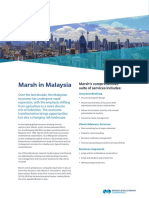Chapter 1: Introduction
1.1 Insurance
Insurance is a legal agreement between an insurance company and a policyholder that
provides financial protection in exchange for a premium payment. The policyholder is the
person or entity that buys the insurance, and the insured is the person or entity covered by the
policy.
Insurance helps protect against financial loss from unforeseen events, such as accidents,
illnesses, or deaths. It can be purchased for a variety of things, including:
cars, homes, healthcare, life, travel, furniture, goods, and machines.
Insurance companies assess the risk of certain events and offer coverage in exchange for a
premium payment. The premium is the amount of money the policyholder pays to the
insurance company for the coverage. The insurance company then uses the premium
payments to cover the costs of claims and to invest in the market.
Insurance can provide peace of mind and financial security. It can also offer tax benefits, such
as deductions for life insurance and medical insurance premiums.
It's important to read your insurance policy to understand what's covered, what exclusions
apply, and what conditions must be met for coverage to apply.
To understand how insurance works, you should know below terms:
Premium: is the money you pay to the insurance company to avail of insurance policy
benefits.
Sum Insured: Sum insured is applicable for a non-life insurance policy like home and health
insurance. It refers to the maximum cap on the costs you are covered for in a year against any
unfortunate event.
Sum Assured: Sum assured is the amount the life insurance company pays to the nominee if
the insured event happens (death of insured).
�1.2 Benefits of Insurance
There are a lot of benefits of buying insurance and listed below are some of them:
Financial Safety for Family: They provide cover against life's uncertainties and protect you
against losses arising from different unexpected events in life.
Safety of Financial Status: Certain events like medical emergencies can have a significant
impact on your cash flow management. Insurance ensures you don't have to pay out of pocket
for such situations.
Wealth Creation Goals: Insurance policies like ULIPs give you investment opportunities
and help you fulfil your essential financial goals.
Wealth Preservation: Life insurance policies like endowment and moneyback plans are
some of the safest long-term investments possible. These plans help you preserve your wealth
from inflation and taxes for long periods.
Wealth Distribution: Few investment plans offer the kind of safety offered by life insurance
pension plans. After retiring at the age of 60, you can live up to 100. Only life insurance
pension plans can guarantee a regular income for that period.
1.3 Principles of Insurance
The concept of insurance is risk distribution among a group of people. Hence, cooperation
becomes the basic principle of insurance.
To ensure the proper functioning of an insurance contract, the insurer and the insured have to
uphold the 7 principles of Insurances mentioned below:
1. Utmost Good Faith
2. Proximate Cause
3. Insurable Interest
4. Indemnity
5. Subrogation
� 6. Contribution
7. Loss Minimization
1.3.1 Principle of Utmost Good Faith
The fundamental principle is that both the parties in an insurance contract should act in good
faith towards each other, i.e. they must provide clear and concise information related to the
terms and conditions of the contract.
The Insured should provide all the information related to the subject matter, and the insurer
must give precise details regarding the contract.
1.3.2 Principle of Proximate Cause
This is also called the principle of ‘Causa Proxima’ or the nearest cause. This principle
applies when the loss is the result of two or more causes. The insurance company will find
the nearest cause of loss to the property. If the proximate cause is the one in which the
property is insured, then the company must pay compensation. If it is not a cause the property
is insured against, then no payment will be made by the insured.
1.3.3 Principle of Insurable interest
This principle says that the individual (insured) must have an insurable interest in the subject
matter. Insurable interest means that the subject matter for which the individual enters the
insurance contract must provide some financial gain to the insured and also lead to a financial
loss if there is any damage, destruction or loss.
1.3.4 Principle of Indemnity
This principle says that insurance is done only for the coverage of the loss; hence insured
should not make any profit from the insurance contract. In other words, the insured should be
compensated the amount equal to the actual loss and not the amount exceeding the loss. The
purpose of the indemnity principle is to set back the insured at the same financial position as
�he was before the loss occurred. Principle of indemnity is observed strictly for property
insurance and not applicable for the life insurance contract.
1.3.5 Principle of Subrogation
Subrogation means one party stands in for another. As per this principle, after the insured, i.e.
the individual has been compensated for the incurred loss to him on the subject matter that
was insured, the rights of the ownership of that property goes to the insurer, i.e. the company.
Subrogation gives the right to the insurance company to claim the amount of loss from the
third-party responsible for the same.
1.3.6 Principle of Contribution
Contribution principle applies when the insured takes more than one insurance policy for the
same subject matter. It states the same thing as in the principle of indemnity, i.e. the insured
cannot make a profit by claiming the loss of one subject matter from different policies or
companies.
1.3.7 Principle of Loss Minimisation
This principle says that as an owner, it is obligatory on the part of the insurer to take
necessary steps to minimise the loss to the insured property. The principle does not allow the
owner to be irresponsible or negligent just because the subject matter is insured.
1.4 Types of Insurance
There are two broad categories of insurance:
Life Insurance
General insurance
�Life Insurance – The insurance policy whereby the policyholder (insured) can ensure
financial freedom for their family members after death. It offers financial compensation in
case of death or disability.
While purchasing the life insurance policy, the insured either pay the lump-sum amount or
makes periodic payments known as premiums to the insurer. In exchange, of which the
insurer promises to pay an assured sum to the family if insured in the event of death or
disability or at maturity.
Depending on the coverage, life insurance can be classified into the below-mentioned types:
• Term Insurance: Gives life coverage for a specific time period.
• Whole life insurance: Offer life cover for the whole life of an individual
• Endowment policy: a portion of premiums go toward the death benefit, while the
remaining is invested by the insurer.
• Money back Policy: a certain percentage of the sum assured is paid to the insured in
intervals throughout the term as survival benefit.
• Pension Plans: Also called retirement plans are a fusion of insurance and investment.
A portion from the premiums is directed towards retirement corpus, which is paid as a
lump-sum or monthly payment after the retirement of the insured.
• Child Plans: Provides financial aid for children of the policyholders throughout their
lives.
• ULIPS – Unit Linked Insurance Plans: same as endowment plans, a part of
premiums goes toward the death benefit while the remaining goes toward mutual fund
investments.
General Insurance – Everything apart from life can be insured under general insurance. It
offers financial compensation on any loss other than death. General insurance covers the loss
or damages caused to all the assets and liabilities. The insurance company promises to pay
the assured sum to cover the loss related to the vehicle, medical treatments, fire, theft, or even
financial problems during travel.
�General Insurance can cover almost anything, and everything but the five key types of
insurances available under it are –
• Health Insurance: Covers the cost of medical care.
• Fire Insurance: give coverage for the damages caused to goods or property due to
fire.
• Travel Insurance: compensates the financial liabilities arising out of non-medical or
medical emergencies during travel within the country or abroad
• Motor Insurance: offers financial protection to motor vehicles from damages due to
accidents, fire, theft, or natural calamities.
• Home Insurance: compensates the damage caused to home due to man-made
disasters, natural calamities, or other threats
1.5 Industry Report
1.5.1 Overview
India’s Insurance industry is one of the premium sectors experiencing upward growth. This
upward growth of the insurance industry can be attributed to growing incomes and increasing
awareness in the industry. India is the fifth largest life insurance market in the world's
emerging insurance markets, growing at a rate of 32-34% each year. In recent years, the
industry has been experiencing fierce competition among its peers which has led to new and
innovative products within the industry.
Over the past nine years, the insurance sector has attracted substantial foreign direct
investment amounting to nearly Rs. 54,000 crore (US$ 6.5 billion), driven by the
government's progressive relaxation of overseas capital flow regulations.
The insurance industry of India has 57 insurance companies - 24 are in the life insurance
business, while 34 are non-life insurers. Among the life insurers, Life Insurance Corporation
(LIC) is the sole public sector company. There are six public sector insurers in the non-life
insurance segment. In addition to these, there is a sole national re-insurer, namely General
Insurance Corporation of India (GIC).
�Other stakeholders in the Indian Insurance market include agents (individual and corporate),
brokers, surveyors and third-party administrators servicing health insurance claims.
The insurance industry has undergone numerous transformations in terms of new
developments, modified regulations, proposals for amendments and growth in 2022. These
developments have opened new avenues of growth for the industry while ensuring that
insurers stay relevant with changing times and the latest digital disruptions.
The Insurance Regulatory and Development Authority India (IRDA) is vigilant and
progressive and is determined to achieve its mission of ‘Insurance for all by 2047’, with
aggressive plans to address the industry’s challenges.
The growth of the insurance market is being supported by important government initiatives,
strong democratic factors, conducive regulatory environment, increased partnerships, product
innovations, and vibrant distribution channels.
Insurance Industry was largely dominated by offline channels like corporate agents, offline
brokers or banks. Today, rapid digitization, product innovation and progressive regulation
policies have made it possible for consumers to buy insurance through multiple distribution
channels with the click of a button. The instability of the covid-19 pandemic highlighted the
necessity for consumers to invest in products that would increase financial security, one of
them being life insurance.
1.5.2 Market Size
The insurance industry in India has witnessed an impressive growth rate over the last two
decades driven by the greater private sector participation and an improvement in distribution
capabilities, along with substantial improvements in operational efficiencies.
In FY24, non-life players’ saw a premium income increase by 19.5% year-over-year to Rs.
1,14,972 crore (US$ 13.8 billion) due to strong demand for health and motor policies. The
business growth for FY24 was driven by health (especially the group segment), motor, and
crop insurance.
The business growth for FY24 was driven by health (especially the group segment), motor,
and crop insurance.
�In 2025 (April- June 2024), life insurers’ new business premiums grew to US$ 10.8 billion,
according to Life Insurance Council data.
In the first-year premium share of life insurance in India, LIC dominates with 64.02%, while
the private sector holds 35.98%.
Among the private players, SBI Life, HDFC Life and ICICI Prudential Life led the industry
in premium collection. SBI Life collected Rs. 7,032.7 crore (US$ 845 million) premium,
while HDFC Life and ICICI Prudential Life received Rs. 6,540.4 crore (US$ 785 million)
and Rs. 3,768.5 crore (US$ 452 million), respectively.
The premium in the month of March 2023 for the private life insurance industry grew at a
healthy pace of 35% on a year-on-year basis and 20% for FY23.
Life insurance firms collected 18% more premiums in FY23 compared to the year before.
Life insurers collected Rs. 3.71 lakh crore (US$ 44.85 billion) as the first-year premium in
FY23 as against Rs. 3.14 lakh crore (US$ 37.96 billion) in FY22, shows the latest IRDAI
data.
Mr. Debashish Panda, Chairman, IRDAI informed that the insurance industry of India has
become a Rs. 59 crore (US$ 7.1 million) industry as of February 2023.
Driven by a pick-up in health and motor insurance segments, the non-life insurance industry
has grown by 16.4% in FY23 compared to 11.1% in the previous year.
In FY24 (Until January) Among the private players, SBI Life, HDFC Life and ICICI
Prudential Life led the industry in premium collection. SBI Life collected Rs. 31,218 crore
(US$ 3.76 billion) premium while HDFC Life and ICICI Prudential Life received Rs. 22,744
crore (US$ 2.74 billion) and Rs. 13,091 crore (US$ 1.58 billion), respectively.
As expected, the state-run insurance behemoth LIC alone contributed over 58.6% to the total
new business premium collection. The insurer received close to Rs. 166,326 crore (US$
20.02 billion) as premium in FY24 (Until January 2024).
According to the latest data released by the insurance regulator – the Insurance Regulatory
and Development Authority of India - LIC improved its market share by 67.72% as of
October, a gain of 447 basis points (bps). At the end of 2021-22, private players had a 36.75%
share of the life insurance market, while LIC had 63.25%.
�With nearly 62.58% of the new business market share in FY23, Life Insurance Corporation of
India, the only public sector life insurer in the country, continued to be the market leader.
In FY23, non-life insurers (comprising general insurers, standalone health insurers and
specialized insurers) recorded a 16.4% growth in gross direct premiums.
In India, gross premiums written off by non-life insurers reached US$ 10.95 billion in FY24*
and US$ 31 billion in FY23.
In the financial year 2023, India's insurance premium penetration accounted for 4% of the
GDP, with life insurance making up 3% and non-life insurance comprising 1%.
The penetration of Indian insurance industry was less than 5% of the GDP. IRDAI data shows
that India’s insurance penetration was 4% of the GDP in 2022-23.
Premiums from India’s life insurance industry is expected to reach Rs. 24 lakh crore (US$
317.98 billion).
The market share of private sector companies in the general and health insurance market
increased from 48.03% in FY20 to 49.31% in FY21 to 62.5% in FY23.
According to S&P Global Market Intelligence data, India is the second-largest insurance
technology market in Asia-Pacific, accounting for 35% of the US$ 3.66 billion Insurtech-
focused venture investments made in the country.
Insurance Density (Premiums Per Capita) (US$)
100
80
60
40
20
0
FY15 FY16 FY17 FY18 FY19 FY20 FY21 FY22 FY23
Life Non-Life
�1.5.3 Investments and Recent Developments
The following are some of the major investments and developments in the Indian insurance
sector:
o In the fiscal year 2023-24, India's non-life insurance sector saw notable growth,
driven mainly by health and motor insurance. Health insurance premiums exceeded
Rs. 1 trillion (US$ 12.02 billion), reflecting a 20.2% increase, while motor insurance
reached Rs. 91,781.3 crore (US$ 11.03 billion), growing by 12.9%.
o In April 2024, CCI has approved Axis Bank Limited's subscription to 14,25,79,161
equity shares of Max Life Insurance Company Limited.
o On January 2024, CCI has approved the merger of Shriram LI Holdings Private
Limited (SLIH) with Shriram Life Insurance Company Limited (SLIC).
o As announced in November 2023, Zurich Insurance Group is set to acquire a majority
stake in Kotak General Insurance, marking the first major foreign investment in
India's insurance sector in eight years. CCI has approved acquisition of 70% stake by
Zurich in Kotak Mahindra Company.
o As announced in June 2023, Go Digit Life Insurance, in which both HDFC Bank and
Axis Bank have bought stakes, plans to invest Rs. 500-600 crore (US$ 60.3-72.4
million) in the initial 18 months to start out as the country's 26th life insurer.
o As informed in September 2023, the UK and India have agreed to launch a
partnership to boost cross-market investment by the insurance and pension sectors.
o In August 2023, Tata AIA launched a ULIP plan with benefits of critical illness cover-
Tata AIA Pro Fit.
o With the introduction of new private sector companies, the insurance sector in India
gained momentum in the year 2000.
o India allowed private companies in insurance sector in 2000, setting a limit on FDI to
26%, which was increased to 49% in 2014 and further increased to 74% in the Union
Budget (Feb’21).
o The market share of private sector companies in the non-life insurance market rose
from 15% in FY04 to 49.3% in FY21.
o Private insurers like HDFC, ICICI and SBI have been some tough competitors for
providing life as well as non-life products to the insurance sector in India.
�o The IPO of Life Insurance Corporation (LIC) of India was the largest IPO ever in
India and the sixth biggest IPO globally of 2022. As of November 2022, listing of LIC
accounted for more than a third of resources mobilised in the primary equity market
until November 2022.
o Insurance market in India is expected reach US$ 222 billion by 2026.
o Robotic Process Automation (RPA) and AI will occupy center stage in insurance,
driven by newer data channels, better data processing capabilities and advancements
in AI algorithms.
o Bots will become mainstream in both the front and back-office to automate policy
servicing and claims management for faster and more personalized customer service.
o Insurers can now launch new health insurance products without IRDAI’s nod. Earlier
the flexibility was given for group insurance products but now retail products have
also come under the new norms.
o The insurance industry is expected to use this opportunity for introduction of
customized and innovative products, expansion of the choices available to the
policyholders in order to address the dynamic needs of the market, which will further
help in enhancing the insurance penetration in India.
o Bajaj Allianz Life Insurance, a private life insurer, has entered into a strategic
partnership with City Union Bank, one of the oldest private sector banks in India. This
partnership will help the private life insurer offer a wide array of life insurance
solutions to the bank’s existing and future customers, across their 727 branches.
o In October 2022, Policybazaar's PBPartners launches its mobile app to facilitate the
ease of insurance business for its advisors digitize their insurance business.
o Canara HSBC Life Insurance launched its ‘Canara HSBC Life Insurance App’ on the
75th Independence Day of India. The app, available on android, iOS devices and web
portal, offers access to policy details, the option to receive timely alerts, pay the
premium, and track fund value, among others.
o ICICI Lombard and Airtel Payments bank have entered into a partnership for
providing cyber insurance in February 2022.
o Probus Insurance receives US$ 6.7 million in funding from a Swiss impact fund in
December 2021.
o Companies are trying to leverage strategic partnership to offer various services as
follows:
� o In November 2021, ICICI Lombard collaborated with Vega to provide a personal
accident insurance cover with every online Vega helmet purchase to increase road
safety awareness among customers.
o In November 2021, ICICI Prudential Life Insurance partnered with NPCI Bharat
BillPay, a subsidiary of National Payments Corporation of India (NPCI), to offer
ClickPay feature to its customers.
o In November 2021, the Competition Commission of India (CCI) approved HDFC Life
Insurance’s acquisition of 100% shareholding in Exide Life Insurance. The move is
expected to strengthen HDFC Life’s position in South India.
o In November 2021, Willis Towers Watson acquired the remaining 51% shares in
WTW India, taking the company’s holding in WTW India to 100%.
o In November 2021, Acko, a digital insurance start-up, raised US$ 255 million in
funds, taking the company’s valuation to ~US$ 1.1 billion.
o In September 2021, ZestMoney raised US$ 50 million to enter new business
opportunities in the insurance sector.
o In August 2021, PhonePe announced that it has received preliminary approval from
IRDAI to act as a broker for life and general insurance products. As a result, the
company can now offer insurance advice to its 300+ million users.
o In FY21, LIC achieved a record first-year premium income of Rs. 56,406 crore (US$
7.75 billion) under individual assurance business with a 10.11% growth over last year.
o In FY23, non-life insurers (comprising general insurers, standalone health insurers
and specialized insurers) recorded a 16.4% growth in gross direct premiums. In India,
gross premiums written off by non-life insurers reached US$ 31 billion in FY23 and
US$ 17.29 billion in FY24 (until September 2023), from US$ 28.14 billion in FY22,
driven by strong growth from general insurance companies.
o In August 2021, ICICI Prudential Life Insurance tied up with the National Payments
Corporation of India (NPCI) to provide a unified payments interface autopay.
1.5.4 Road Ahead
The future looks promising for the life insurance industry with several changes in the
regulatory framework which will lead to further changes in the way the industry conducts its
�business and engages with its customers. Going forward growing middle class, increasing
awareness about the importance of insurance, and digital advancements, the sector is
expected to expand further increasing life expectancy, favourable savings and greater
employment in the private sector is expected to fuel demand for pension plans. Life insurance
industry in the country is expected to increase by 14-15% annually for the next three to five
years. The scope of IoT in Indian insurance market continues to go beyond telematics and
customer risk assessment. Currently, there are 110+ InsurTech start-ups operating in India.
These startups are expected to provide a major boost to the industry and help increase India’s
insurance penetration which plays a crucial role in the overall development of the country. In
the past, the Indian government has played a crucial role in increasing the scope of the
insurance sector through various policies and schemes. This trend will continue in the further
through schemes like the Pradhan Mantri Fasal Bima Yojana (PMFBY) providing crop
insurance and Pradhan Mantri Jeevan Jyoti Bima Yojana (PMJJBY) providing life insurance
coverage to the youth at an affordable price.
Schemes like these coupled with India’s demographic factors such as a growing middle class,
young insurable population, and growing awareness of the need for protection and retirement
planning will support the growth of the Indian insurance sector.









